Rank Species | Suborder Apocrita Subfamily Xylocopinae Higher classification Carpenter bee | |
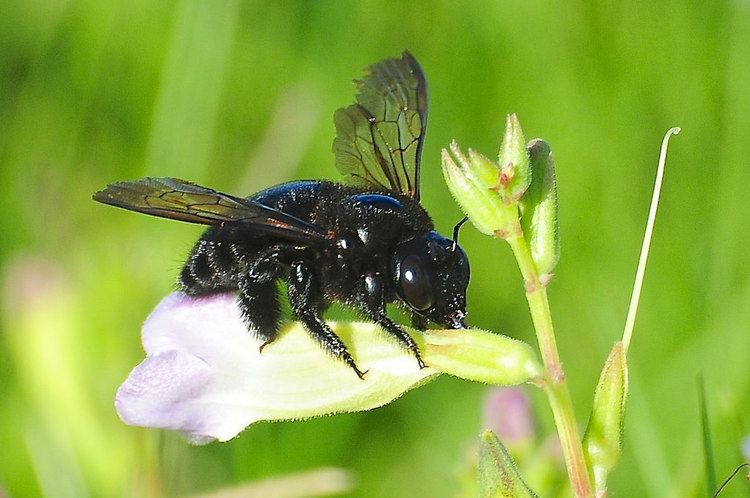 | ||
Similar Carpenter bee, Bee, Insect, Apidae, Hymenopterans | ||
Xylocopa sonorina, commonly known as the Sonoran carpenter bee, is a carpenter bee found in the eastern Pacific islands. Males are golden brown and lack stingers; females are black and larger than the males and considered shy. In tropical climates, females will lay eggs all year, with interruptions due to cold weather. After collecting pollen and preparing tunneled chambers out of wood, a single female will deposit eggs on pollen balls within the chamber and seal it. The eggs will hatch two to three days later, with larvae maturing in two weeks, and prepupal and pupal stages lasting 3–4 weeks. New adults will begin buzzing a week later and flying in two to three more weeks.
Contents
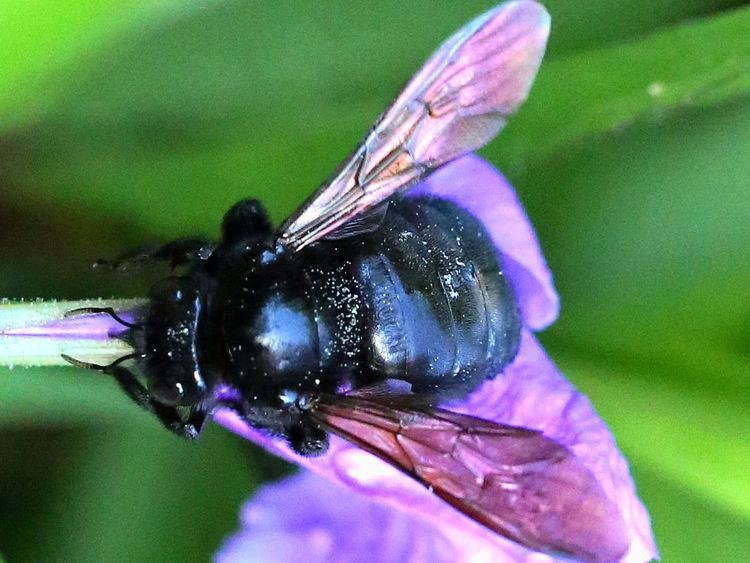
The Sonoran carpenter bee is distinguished from other species of the genus by differences in their genitalic morphology. The species is one of 11 non-native bees in the U.S. state of Hawaii. Humans are thought to have helped the species colonize Pacific archipelagos. It is not known when X. sonorina was introduced to the Hawaiian Islands, but sometime around 1874, British entomologist Frederick Smith identified it as a new species. X. sonorina is currently found on all of the main Hawaiian Islands except for Kauaʻi, and in the Mariana Islands. In tropical agriculture, X. sonorina has been used as a pollinator of Passiflora edulis, a species of passion fruit.

Taxonomy
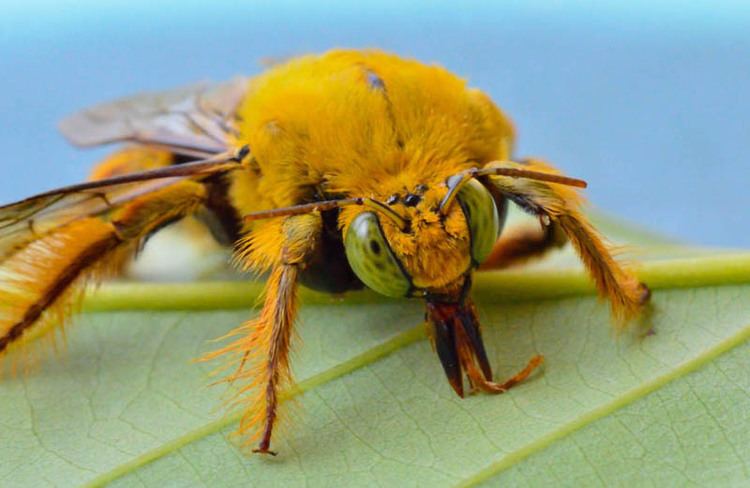
Frederick Smith, Assistant in the Zoological Department of the British Museum and member of the council of the Entomological Society of London, first identified X. sonorina in 1874. The species was misidentified several times after Smith. In 1899, R. C. L. Perkins described the species as Xylocopa aeneipennis, and in 1922, P. H. Timberlake identified it as Xylocopa varipuncta.

Until 1956, it was thought that X. sonorina came from the Sunda Islands. In a paper published that year, M. A. Lieftinck showed that Smith's data was in error: Smith had mistakenly attributed the habitat of X. sonorina to the Sunda Islands instead of the Sandwich Islands. Roy R. Snelling predicts that X. sonorina will eventually be described as a synonym of X. varipuncta, however, the two species are presently distinguished by alleged differences in their genitalic morphology.
Description
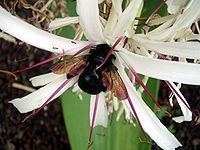
The male bees are golden brown in color and lack a stinger; Females are large and black, with a length of approximately 1 inch. The female can sting if angry but she is considered shy. While she looks impressive, X. sonorina rarely stings humans. Carpenter bee venom is composed of proteins which can produce allergies; Some individuals must be stung in at least two separate instances before an allergic reaction develops. It is unknown if people allergic to honeybee venom are also allergic to carpenter bee venom.
Smith first described the species in a monograph published by the Entomological Society of London in 1874:
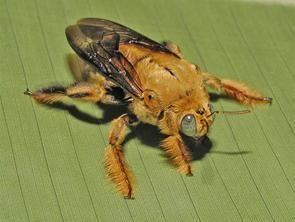
Female.—Black; head and thorax closely and moderately punctured; the mesothorax smooth, impunctate and shining on the disk; metathorax rounded behind; abdomen shining rather finely punctured, most closely so at the sides above; the pubescence entirely black, except that on the anterior tarsi beneath, which is ferruginous; the claws of the tarsi ferruginous; wings fusco-hyaline, with a darker cloud beyond the enclosed cells, and adorned with a bright purple and coppery iridescence. Length ten to eleven lines. Hab.—Sunda Islands.
Distribution
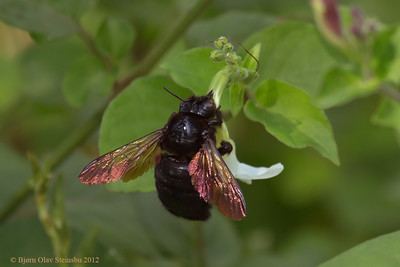
According to entomologist Paul D. Hurd Jr., it is unknown when and how X. sonorina managed to reach the Hawaiian Islands. Located in the Pacific Ocean, more than 2,000 mi (3,219 km) away from the closest landfall in North America, Hawaii's great distance from the Americas is thought to have been too large for natural biological dispersal to succeed. Hurd suggests that it is likely humans aided X. sonorina in its arrival to Hawaii. Today, the species can be found on all of the main Hawaiian Islands except for Kauaʻi. Following the colonization of Hawaii, X. sonorina was introduced into the Marianas Islands, China, Japan, and the United States. The species has also been reported in Midway Atoll, Java, New Guinea, and the Philippines.
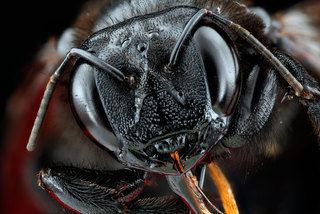
Hurd observes that in recent history, only two species in the genus Xylocopa have successfully colonized Pacific archipelagos east of the Americas through natural biological dispersal or with human help; This is out of a total of more than 150 identified species in North and South America, 70 of which can be found in Brazil alone. The two species include: Xylocopa darwinii, found in the Galápagos Islands, 604 mi (972 km) west of South America, with the mainland of Ecuador as the closest land mass; and Xylocopa clarionenis, found on Clarión Island in the Revillagigedo Islands, 700 mi (1,127 km) from the coast of Mexico. X. clarionenis is thought to be most closely related to Xylocopa varipuncta.
Life cycle
Entomologist Julian R. Yates III of the University of Hawaii at Manoa describes the life cycle of X. sonorina in Hawaii:
Having located a suitable piece of wood, the female bee begins to excavate a single tunnel in preparation for egg laying. Because of our tropical climate, egg laying by female carpenter bees occurs year-round although it may decline during the winter months, when the weather is worse. Before laying eggs, the female collects pollen and deposits it, in the form of a ball, in the tunnel at a point furthest from the entrance. She lays a single egg on the pollen ball and seals both in a chamber with wood shavings. She may lay several eggs, each on its own pollen ball and inside its own sealed chamber, in a series within the tunnel. The eggs hatch in two to three days. The larvae develop in approximately two weeks. The prepupal (nonfeeding larvae) and pupal stages take about three to four weeks to reach adulthood. Teneral (adult shortly after emergence, when it is not entirely hardened or not of the mature color) females are fed by the mother. They are capable of buzzing in about a week, and of flight in approximately two to three weeks. A single female in a tunnel may be joined later by her offspring or other bees. Only one female will collect pollen, prepare cells, and lay eggs, however. Other females perform guard and nest-cleaning duties.
Behavior
The foraging behavior of X. sonorina involves a quick series of movements between flowers. In a 1996 study of bee behavior by Ethel M. Villalobos and Todd E. Shelly using Asystasia gangetica (Chinese violet), X. sonorina visited 16 flowers per minute and spent an average of 1.5 seconds at each flower, usually flying towards the flower from the front, landing on the petals, and moving to the bottom of the corolla. Entomologist Edward M. Barrows studied this behavior and found that X. sonorina was a primary and secondary nectar "robber" of A. gangetica since it "took nectar through perforations and did not contact stigmas in doing so." Floral robbery occurs when the carpenter bee makes perforations near the base of the tubular corolla of the flower to obtain nectar, but does not pollinate the flower in return.
In Hawaii and Niue Island, Xylocopa sonorina serves a crucial role in tropical agriculture as a pollinator for Passiflora edulis, a variety of passion fruit. While their pollination services are appreciated, the nesting habits of carpenter bees frequently lead to their designation as pests. These bees exhibit a preference for burrowing into wood to establish their nesting sites. Due to this problem, in 1934, a blister beetle (Cissites auriculata) was brought to Hawaii in an attempt to decrease the number of X. sonorina; Reportedly, C. auriculata did not survive.
